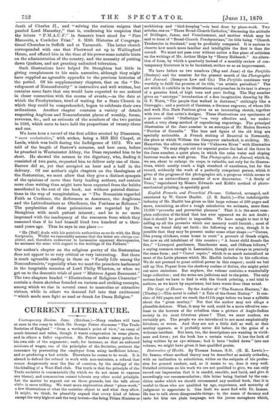CURRENT LITERATURE.
Contemporary Review. June. (Strahan.)—Many readers will turn at once to the essay in which Mr. George Potter discusses "The Trade Societies of England " " from a workman's point of view," an essay of much interest and value, though it wants compression in some places, and in others a fuller exposition. Mr. Potter makes many points for his own side of the argument ; such, for instance, as that an enforced minimum of wages, one of the principles of the Societies, protects the consumer by preventing the employer from using inefficient labour, and so producing a bad article. Elsewhere he seems to be weak. It is absurd to defend the refusal to work with non-unionists, a refusal that comes dangerously near the line of coercion, by the analogy of the blackballing of a West-End club. The truth is that the principle of the Trade societies is communistic (by which we do not mean to express any blame), and communism cannot tolerate any other social principle. Let the matter be argued out on these grounds, but the talk about clubs is mere trifling. We want more explanation about "piece-work," a few illustrations of what the societies object to and what they allow. It might, we think, be plausibly argued that every kind of labour except the very highest and the very lowest—the being Prime Minister or
archbishop and "bird-keeping "—is best done by piece-work. Two articles, one on " Three Broad-Church Catholics," discussing the attitude of Dollinger, Janus, and Froschammer, and another which may be said to treat of " Broad-Church Presbyterians," its title being "Church Tendencies in Scotland," may be profitably compared. It is curious to observe how much more familiar and intelligible the first is than the second. We must not pass over without notice a fine piece of criticism on the writings of Mr. Arthur Helps by "Henry Holbeach." An altera- tion of form, by which a quarterly instead of a monthly review of con- temporary literature is to be furnished, strikes us as an improvement.
We have before us two numbers (May and June) of the Portfolio (Seeleys) and the number for the present month of the Photographic Art Journal. (Sampson Low and Co.) The Portfolio continues very worthily to fulfil the promise of its title, "an artistic periodical" The art which it exhibits in its illustrations and preaches in its text is always of a genuine kind, of high tone and pure feeling. The May number gives an " autotype " introduction of a fine imaginative drawing by Mr. G. F. Watts, "The people that walked in darkness," strikingly like a Correggio ; and a portrait of Carstens, a German engraver, of whose life and work Mrs. Mark Pattison gives us an interesting sketch, together with two of that artist's designs. These illustrations are specimens of a process called " Dallastype "—a very effective and, we under- stand, a very cheap method of reproducing engravings. The principal illustration of the June number is an autotype of Mr. Medea Brown's "Portion of Cornelia." The face and figure of the old king are specially noticeable. A French etching of Beuzdval in Normandy, the place at which William the Conqueror embarked, is striking. Mr. Hamerton, the editor, continues his "Unknown River" with illustrative etchings. We may single out for especial praise the last of the three in the June number, a quiet place, in which the calm water and sloping lustrous woods are well given. The Photographic Art Journal, which is, we see, about to enlarge its scope, is valuable, not only for its illustra- tions, which mostly reach a high standard of excellence, but for the record, evidently the work of a perfectly competent person, which it gives of the progress of the photographic art, a progress which seems to lead to an extraordinary number of now discoveries. "A Study of Trees," reproduced by Messrs. Edwards and Kidd's method of photo- mechanical printing, is specially good.






























 Previous page
Previous page